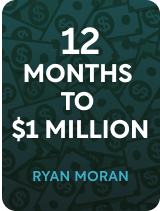
Do you have a business idea that you think will make millions? How can you turn that idea into a reality?
If building a million-dollar business in a single year sounds impossible, then entrepreneur Ryan Moran has news for you. In 12 Months to $1 Million, Moran writes that it’s not only possible but simple: All you need to do is to sell three to five products tailored to a specific audience.
Read below for a brief 12 Months to $1 Million book overview.
12 Months to $1 Million by Ryan Moran
In the 12 Months to $1 Million book, entrepreneur Ryan Moran presents a roadmap for starting and growing a successful million-dollar business in a single year. He explains that all you need to do to reach that seven-figure mark is to sell three to five products tailored to a specific audience. To help you achieve this goal, Moran shares proven techniques for creating breakthrough products, marketing your business, and developing a brand with loyal, dedicated customers. By following his approach, you can turn your ideas into reality, achieve your financial goals, and run a million-dollar business within the course of a year.
Moran is an investor, podcaster, and founder of Capitalism.com, where he helps entrepreneurs build successful million-dollar businesses. He’s helped over 100 entrepreneurs create million-dollar businesses using his method. His first million-dollar business was a supplements company he co-founded called Sheer Strength.
In this guide, we’ll first discuss what you need to build a million-dollar business in a single year. Then, we’ll dive into the specific steps, starting with Moran’s method for creating a product. We’ll also discuss how to plan a profitable launch and grow your sales afterward. Finally, we’ll examine Moran’s tips for deciding whether to scale or sell your business once it’s reached the million-dollar mark. Throughout, we’ll compare Moran’s strategy with that of other entrepreneurs and provide actionable tips for applying his strategy to your own business.
How to Build a Million-Dollar Business in One Year
Moran writes that to create a million-dollar business, you need to sell three to five products that generate 25 to 30 sales per day at around $30 each.
According to Moran, to achieve these numbers, you must create a brand by having a coherent line of products that all serve the same customer, and then make your customer trust that brand. With this in mind, let’s delve into Moran’s method for building your business—starting with creating your first product.
Step 1: Develop Your First Product
According to Moran, to create a winning product, you must first identify the audience you want to sell to and then specially design a product that meets their wants or needs—it should solve a problem your specific niche audience has. Developing a product that speaks to a distinct group of people ensures you have something that people will be interested in buying and allows you to tailor your product to their needs better than other products that cater to everyone. This allows you to build a brand with unique value that will have loyal, repeat customers.
Step 2: Launch Your Product
Once you’ve created your first product, your next step is to launch it online and start taking sales. To ensure your product gets sales, Moran writes that you must build an audience that’s excited and interested in your product before it’s available. You can do this by creating valuable content and driving traffic to a platform where you can communicate with your audience.
According to Moran, the engagement of your audience matters more than its size. However, he suggests you aim for 1,000 followers, 10 personal connections, and one influencer if possible (although you should still launch if you can’t meet these numbers). He explains that with this level of engagement, you can expect to make a hundred sales on your first launch day.
Let’s look at Moran’s tips for growing an audience for a profitable product launch.
Plan the Logistics of Your Launch
To successfully attract an audience to your product launch, you must work out the logistics of your launch. This will allow you to effectively publicize it and then ensure that your audience can properly interact with you, your company, and your product at the right time. Moran suggests you determine when you’ll launch your product, what platforms you’ll sell it on, and how you’ll communicate with your audience.
1. Plan your launch date. Moran suggests you plan to launch a few days after you think your product will be ready. This way, you ensure that you’re fully prepared to take sales and avoid wasting your marketing efforts if something gets delayed.
2. Decide where to sell your product. Moran suggests Amazon, Kickstarter, your own store, or a combination of the three.
3. Decide what platform you’ll use to interact with your audience—for example, Facebook, Instagram, or LinkedIn. Moran suggests you think about where your audience is most active and go there.
Create Content and Engage With Your Audience
Now that you’ve prepared the logistics of your launch, it’s time to build anticipation and attract followers. You can do this by creating engaging content and interacting with people in your target audience.
But what kind of content should you create? Moran recommends you use a format you’re comfortable with—whether that’s writing blog posts, creating videos, or hosting a podcast—and share your business’s journey with your audience—for example, let them see how your product is coming along, share your feelings about the launch, and answer common questions they may have. Creating such content spreads the word about your product launch and gets people excited about it.
In addition to creating content, Moran suggests you interact with your audience as much as possible. Join conversations they’re having, weigh in on popular topics, and respond to every comment and message you get. Interacting with your audience helps build trust and loyalty, which are essential for building a successful brand and having a successful launch.
Recruit People to Support Your Launch
In addition to building engagement yourself, Moran suggests you recruit other people to support your launch.
First, he suggests you reach out to ten people in your personal network. Ideally, they should belong to your target audience. Give them your product for free and ask them to post about your product. This is an easy way to spread awareness about your launch and cultivate a positive impression of your product.
Another way to get more attention for your launch is by finding an influencer to promote it. Moran suggests you connect with smaller influencers who have around 10,000 followers. They have enough influence to boost your sales and are also more likely to agree to work with you. To get an influencer to support your product launch, Moran recommends that you give them something first rather than ask them for a favor. Think of what you can offer them—one of the easiest ways is to offer money, Moran writes, but you could also share their content or send a gift. He writes that focusing on building a relationship first rather than trying to make a transaction makes people more willing to work with you.
Create Incentives for Early Buyers
As you near your launch date, ramp up the anticipation by creating incentives for people to buy your product when it launches. Moran suggests two ways of doing this:
1. Create a priority list. Make a list that gives priority access to people most eager to buy your product. To create this list, announce that you have a limited supply of your product and that you can’t guarantee there’s enough for everyone to purchase when it launches. Then, ask people to comment with a specific phrase (like “Save one for me!”) if they want one reserved for them. You can also create an exclusive communication channel with these priority customers to make them feel valued. Moran notes that priority lists create a sense of scarcity—people become more eager to buy because they don’t want to miss out on your product. Plus, by reserving products for people, you ensure you’ll have buyers on your launch date.
2. Give special bonuses. Another way to get more sales when you launch is to offer special bonuses for people who buy your product in the first few days of your launch. You could consider doing a BOGO deal or giving an extra feature or freebie. These bonuses will motivate customers to buy early to avoid missing out on the opportunity.
Step 3: Grow Your Sales
Once you’ve launched your first product and are taking sales, Moran writes that your focus should be on maintaining momentum and growing your sales. Your goal is to reach 25 sales per day. Moran explains how you can achieve that level of sales by effectively maintaining your inventory and funding and by creating positive buzz around your product.
Maintain Your Inventory and Funding
Once you’ve launched your product, you must manage your inventory and keep your product in stock. Running out of your product can be disastrous for your business: It prevents you from making revenue, destroys your sales momentum, and loses customer engagement. Managing your inventory can be tricky, however, because you have to anticipate the demand for your product. If your product gains sudden popularity and your sales volume spikes, you might run out of stock and be unable to fulfill all the orders.
One main challenge to keeping your product in stock is having enough money to order it. Moran recommends you have $10,000 available at your disposal at all times for this purpose.
If you don’t have that kind of money, there are some other options you can consider to fund your business:
Option #1: Find an investor. Bringing in an outside investor can be one of the quickest ways to get money, Moran writes. To give a successful pitch to an investor, Moran suggests you ask them for advice, not money: First, tell them how well your product is selling and how you plan to continue growing your business. Then, ask how they would fund your business if they were you. Asking for advice opens people to helping you, while asking for money closes them up.
Option #2: Run a crowdfunding campaign. You can get regular people to support your business through crowdfunding sites like Kickstarter. To create a compelling campaign, Moran suggests you create a video showcasing your product, your goals, and your plans for the future.
Option #3: Borrow money. Another way to fund your business is to get a loan. But, this option has some drawbacks: It can take a long time to get approved and you’ll have to pay it back with interest. Moran recommends you borrow money only when you know you’ll make money by using it—for example, when you’re sure you can sell all of your inventory and make a profit. Don’t borrow money for things that have no guaranteed profit. For example, don’t take on debt for advertising, because you don’t know how much money ads will bring in.
Once you’ve figured out how to pay for your inventory, consider Moran’s tips for avoiding a stockout:
Tip #1. Don’t wait to restock your inventory. Reorder as soon as you know your product has some demand. This should be right as your launch ends or when you start getting more than 10 sales daily.
Tip #2: Increase your product price. If your product is selling faster than you can restock your inventory, Moran recommends raising the price of your product to slow the rate of sales.
Tip #3: Place big inventory orders. Ordering your products in bulk not only allows you to avoid the risk of stockouts, but it also gives you more room to negotiate discounts with your supplier.
Get Positive Reviews
Maintaining your inventory helps you sustain your sales, but how do you increase your sales to 25 per day? According to Moran, the best way to do this is to get more positive reviews, which you can do by engaging with your customers—the real force behind your sales. This means responding to comments and reviews, getting testimonials, and continuing to share the growth of your business. Being active with your audience helps you grow a sense of community, trust, and loyalty, while also increasing awareness about your product.
To get more positive reviews, Moran suggests you ask for feedback from your customers and then reward them for giving it. For example, you might ask how they like the product, give them a discount code when they reply, and then ask them to leave a review on the product.
Once you receive good feedback or reviews, Moran suggests you screenshot them and share them on social media. This shows your audience that you care about their opinions and also displays their satisfaction with your product.
Step 4: Launch the Rest of Your Product Line
According to Moran, once your product is making at least 25 sales per day, it’s time to launch your next product. Remember, you need three to five products, each selling 25 to 30 a day at around $30 each to reach seven figures with your business. To achieve this goal, you must repeat the process for the rest of your product line while continuing your advertising efforts.
When launching the rest of your product line, Moran writes that you must focus most on advertising your brand and exposing it to new audiences. You can do this in a number of ways, but Moran argues that the most effective way is to build relationships with more influencers. They already have large followings and are seen as trendsetters, which allows you to reach new potential customers quickly. Moran suggests you form more connections with relevant smaller creators, as we’ve discussed earlier. Ask them to promote your platform and encourage their followers to subscribe to it. Once you form relationships with smaller creators, Moran suggests you network with bigger creators to gain access to even larger audiences.
Step 5: Decide Whether to Scale or to Sell Your Business
Once you’ve launched your entire product line and reached $100,000 in sales per month, you have a million-dollar business. So, what’s next? First, Moran writes that you can start paying yourself. Up until this point, you’ve been working hard and reinvesting your profit into growing your business. Moran suggests you pay yourself enough to work on your business full-time.
Next, you have two options for what to do with your business: you can keep growing it or to sell it to another company.
If you choose to keep growing your business, you should focus on transforming it from a sales machine that depends on your constant involvement to a sustainable business that can operate without you. To do this, Moran suggests you reinvest your profits in advertising your brand, creating content, improving logistics, and hiring team members. This frees up your time and energy so that you can focus on expanding your business.
If you choose to sell your business, Moran suggests you focus on your long-term goals. You’ll likely retain a minority stake in your business and receive payments based on how well it performs, so he advises that you don’t settle for a quick payout and sell your business to someone who will treat it poorly. Instead, find a buyer you trust and are willing to work with. By selling it to someone who’ll treat your business well, you ensure that your business thrives and that you’ll continue to reap the rewards of your hard work.

———End of Preview———
Like what you just read? Read the rest of the world's best book summary and analysis of Ryan Daniel Moran's "12 Months to $1 Million" at Shortform.
Here's what you'll find in our full 12 Months to $1 Million summary:
- Why it's not only possible, but simple, to build a $1 million business in a year
- Proven techniques for creating breakthrough products
- How to decide whether to scale or sell your business






